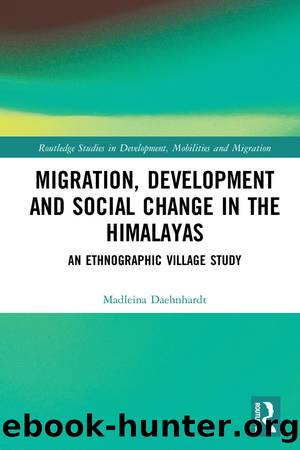Migration, Development and Social Change in the Himalayas by Madleina Daehnhardt

Author:Madleina Daehnhardt [Daehnhardt, Madleina]
Language: eng
Format: epub
ISBN: 9780367785130
Barnesnoble:
Publisher: Taylor & Francis
Published: 2021-03-31T00:00:00+00:00
Long-term out-migration for army and private sector jobs
The role of capabilities in male out-migration
The multidimensional effects of out-migration are further visible in the case of long-term out-migration of men for a variety of jobs, including military and police recruitment, as well as labour in the private service sector. Private sector jobs are primarily pursued by general caste and SC men, while the trend for army recruitment spreads across all caste lines. Twenty-five percent of all out-migrants from Tejam are employed by police or military departments.12 The historic tradition of Kumauni men joining the army is still prevalent today (Walton, 1911).13 Tejamâs village head links the widespread trend to the comparatively lower educational levels of villagers. The chance of being recruited to the army and police is higher than recruitment to other government departments which may require more specialised education. Since educational requirements for army service are comparatively lower, competition among a wide pool of eligible villagers is fierce. Joining the army or police is an aspiration of many young pupils and recent graduates of the Inter College in Tejam.
A general caste household family tree over four generations exemplifies the trend for recruitment of army personnel from general caste households in Tejam (see under the eResources tab at www.routledge.com/9780367150969). Ram Singh Maharâs four sons â Dhan Singh, Kunwar Singh, Pratap Singh and Pushkar Singh â have been recruited in the army. The youngest sons, Pratap and Pushkar, have settled in Haldwani where all their children attend English-medium schools. Dhan Singh and Kunwar Singh have retired in Tejam and their sons who remain in Tejam are engaged in professional activities (as village head, lab assistant in the Inter College and flour mill owner), while their wives remain farm women. Those who have not been educated in high-quality schools (i.e. English-medium urban private schools) are more likely to continue their traditional lives. This is visible in the case of Ram Singhâs first daughter, Khimuli Devi, whose offspring have all been locally educated in Hindi-medium government schools and none of whom are in employment, but are instead engaged in farming. The education- employment link is noticeable in some exceptional cases in general caste households and is comparable to the trend of access to capabilities of women in Shauka households. In the Mahar tree, Lacchima Devi and Gopal Singhâs son and daughters were all educated outside Tejam when living with their father, an honorary captain. They completed B.A. and M.A. degrees and, while the son now works in the Bank of Baroda, both daughters are teachers and their husbands work for ITBP and BSF.
Improved access to opportunities in education, employment and political liberties â what has been described as âgoodsâ in the capabilities approach â as the result of affirmative action is visible in the SC family tree case study under the eResources tab at www.routledge.com/9780367150969. The following members benefited from preferential policies due to their status as scheduled castes: Harak Ram, who is employed by ITBP, left Tejam and settled in Pithoragarh with his family, while he rents out his house in Tejam to an Inter College teacher.
Download
This site does not store any files on its server. We only index and link to content provided by other sites. Please contact the content providers to delete copyright contents if any and email us, we'll remove relevant links or contents immediately.
Man-made Catastrophes and Risk Information Concealment by Dmitry Chernov & Didier Sornette(5653)
The Revenge of Geography: What the Map Tells Us About Coming Conflicts and the Battle Against Fate by Kaplan Robert D(3962)
Zero Waste Home by Bea Johnson(3655)
In a Sunburned Country by Bill Bryson(3369)
COSMOS by Carl Sagan(3350)
Good by S. Walden(3347)
The Fate of Rome: Climate, Disease, and the End of an Empire (The Princeton History of the Ancient World) by Kyle Harper(2875)
Camino Island by John Grisham(2721)
A Wilder Time by William E. Glassley(2690)
Organic Mushroom Farming and Mycoremediation by Tradd Cotter(2567)
The Ogre by Doug Scott(2503)
Human Dynamics Research in Smart and Connected Communities by Shih-Lung Shaw & Daniel Sui(2431)
Energy Myths and Realities by Vaclav Smil(2381)
The Traveler's Gift by Andy Andrews(2300)
9781803241661-PYTHON FOR ARCGIS PRO by Unknown(2271)
Inside the Middle East by Avi Melamed(2232)
Birds of New Guinea by Pratt Thane K.; Beehler Bruce M.; Anderton John C(2175)
A History of Warfare by John Keegan(2106)
Ultimate Navigation Manual by Lyle Brotherton(2050)
